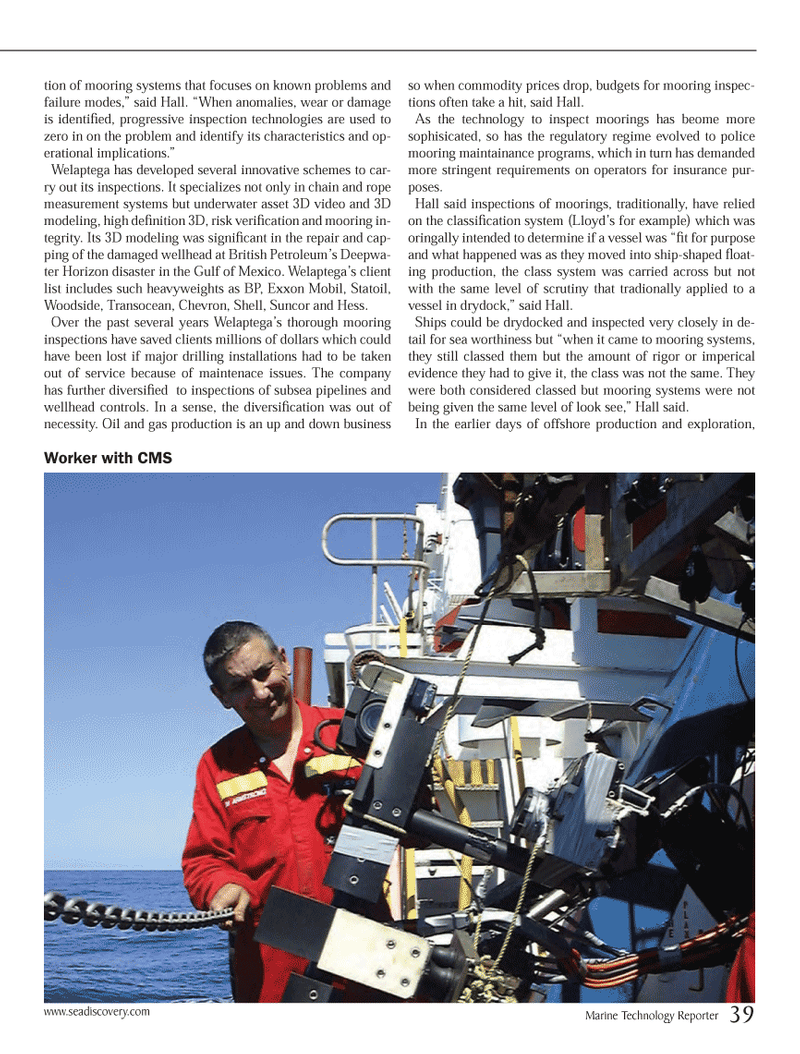
Page 39: of Marine Technology Magazine (September 2013)
Ocean Observation: Gliders, Buoys & Sub-Surface monitoring Networks
Read this page in Pdf, Flash or Html5 edition of September 2013 Marine Technology Magazine
tion of mooring systems that focuses on known problems and failure modes,? said Hall. ?When anomalies, wear or damage is identi ed, progressive inspection technologies are used to zero in on the problem and identify its characteristics and op-erational implications.? Welaptega has developed several innovative schemes to car- ry out its inspections. It specializes not only in chain and rope measurement systems but underwater asset 3D video and 3D modeling, high de nition 3D, risk veri cation and mooring in- tegrity. Its 3D modeling was signi cant in the repair and cap- ping of the damaged wellhead at British Petroleum?s Deepwa- ter Horizon disaster in the Gulf of Mexico. Welaptega?s client list includes such heavyweights as BP, Exxon Mobil, Statoil, Woodside, Transocean, Chevron, Shell, Suncor and Hess. Over the past several years Welaptega?s thorough mooring inspections have saved clients millions of dollars which could have been lost if major drilling installations had to be taken out of service because of maintenace issues. The company has further diversi ed to inspections of subsea pipelines and wellhead controls. In a sense, the diversi cation was out of necessity. Oil and gas production is an up and down business so when commodity prices drop, budgets for mooring inspec- tions often take a hit, said Hall. As the technology to inspect moorings has beome more sophisicated, so has the regulatory regime evolved to police mooring maintainance programs, which in turn has demanded more stringent requirements on operators for insurance pur- poses.Hall said inspections of moorings, traditionally, have relied on the classi cation system (Lloyd?s for example) which was oringally intended to determine if a vessel was ? t for purpose and what happened was as they moved into ship-shaped oat-ing production, the class system was carried across but not with the same level of scrutiny that tradionally applied to a vessel in drydock,? said Hall. Ships could be drydocked and inspected very closely in de- tail for sea worthiness but ?when it came to mooring systems, they still classed them but the amount of rigor or imperical evidence they had to give it, the class was not the same. They were both considered classed but mooring systems were not being given the same level of look see,? Hall said. In the earlier days of offshore production and exploration, Worker with CMS www.seadiscovery.com Marine Technology Reporter 39MTR #7 (34-49).indd 39MTR #7 (34-49).indd 398/26/2013 11:19:22 AM8/26/2013 11:19:22 AM

 38
38

 40
40
